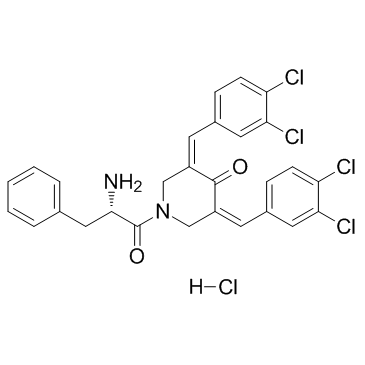| Description |
RA190, a bis-benzylidine piperidon, inhibits proteasome function by covalently binding to cysteine 88 of ubiquitin receptor RPN13.
|
| Related Catalog |
|
| Target |
IC50: 0.15 μM (HeLa cell)
|
| In Vitro |
RA190 covalently binds to cysteine 88 of ubiquitin receptor RPN13 in the 19S regulatory particle and inhibits proteasome function, triggering rapid accumulation of polyubiquitinated proteins. Multiple myeloma (MM) lines, even those resistant to bortezomib, are sensitive to RA190 via endoplasmic reticulum stress-related apoptosis. RA190 stabilizes targets of human papillomavirus (HPV) E6 oncoprotein, and preferentially kills HPV-transformed cells[1].
|
| In Vivo |
RA190 distributes to plasma and major organs excepting brain, and inhibits proteasome function in skin and muscle. RA190 administration profoundly reduces growth of multiple myeloma and ovarian cancer xenografts, and oral RA190 treatment retards HPV16+ syngeneic mouse tumor growth, without impacting spontaneous HPV-specific CD8+ T cell responses[1].
|
| Cell Assay |
RA190 is dissolved in DMSO and diluted with cell culture medium. HeLa cells are treated with RA190 (0.2, 0.4, 0.6, 0.8, 1, 2, 3, 4, 5 μM) for 48 hr. Cell viability is assayed using commerical kit[1].
|
| Animal Admin |
Mice: Mice are divided into two groups and treated daily i.p. with RA190 (10 mg/kg) or vehicle, and imaged again on day 7 and day 14. NOG mice (5 per group) are inoculated with 1X106 NCI-H929-GFP-Luc cells i.v., and after 4 weeks, mice are imaged for their luciferase activity and divided into two groups. Mice are treated i.p. with RA190 (20 mg/kg) or vehicle, and imaged again at the end of the treatment for their luciferase activity[1].
|
| References |
[1]. Anchoori RK, et al. A bis-benzylidine piperidone targeting proteasome ubiquitin receptor RPN13/ADRM1 as a therapy for cancer. Cancer Cell. 2013 Dec 9;24(6):791-805.
|
